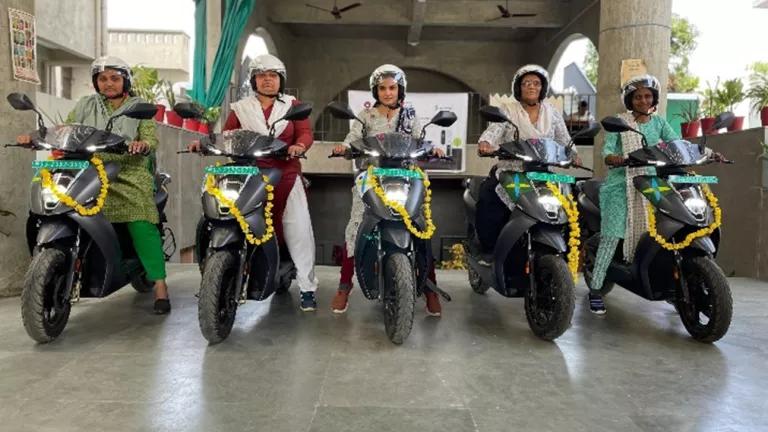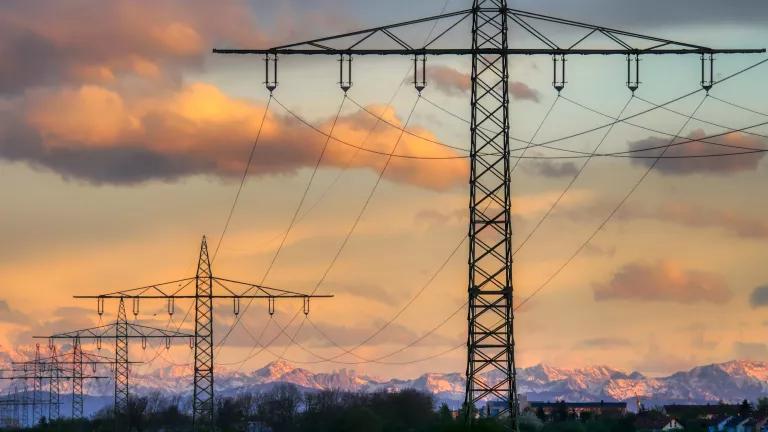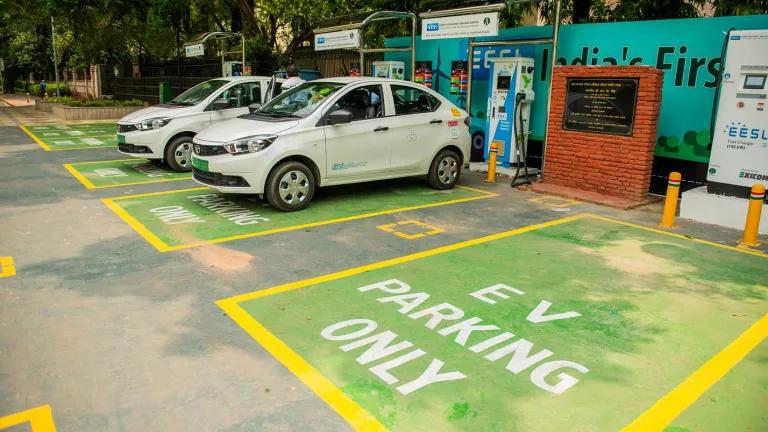Mobilizing Renewable Energy for EV Charging in India
India is working to reach its goal of 30% electric vehicle sales by 2030 while ensuring a green transition.

Electric cars charging through solar energy
Guest blog by Charu Lata and Nishara Fernando.
For many in India, driving an electric vehicle (EV) is part of living a “greener” life. However, the electricity used to charge EVs can often come from conventional fuels like coal and natural gas. Fortunately, the Green Energy Open Access Rules 2022 has the potential to mitigate against this quandary. The Open Access Rules, which the Ministry of Power notified in early June, enable consumers to purchase green energy (minimum 100 kilowatts) directly from renewable energy producers, paving the way to charging EVs using renewable energy in India. With India’s plan of reaching 30% electric vehicle sales by 2030 while ensuring a green transition, it is key to accelerate the adoption of EVs along with scaling up of renewable energy-based EV charging mechanisms.
Carbon emissions associated with electricity generation in India are well above the global average as India widely employs coal-fired power plants to generate its electricity. This electricity is subsequently utilized to charge EVs, which means India is not yet harnessing the potential power of consumers switching from conventional vehicles to EVs to reduce carbon emissions. To reap the optimal benefit of switching to EVs, the carbon emissions intensity in the electricity grid needs to be lower - from the current 725 grams of CO2 per kilowatt‐hour (g CO2/kWh) to 700 g CO2/kWh or less.
With India’s COP26 conference announcement that it intends to scale its non-fossil fuel generation to 500 GW by 2030, the share of clean energy in the Indian electricity grid will ramp up significantly over the coming decade. The government and private companies can support the transition to charging EVs using renewable energy by adopting several emerging mechanisms described below. The majority of these mechanisms are being implemented internationally and a few have been tried in India at varying scales.
Mechanisms for scaling up renewable energy-based EV charging
Network Charging provides access to a network of charging stations where customers can charge their EVs with renewable energy. This has two common operational models - providing direct access to electricity generated from offsite renewable sources such as the Plug-In Everywhere program by Austin Energy or offsetting each kilowatt-hour consumed by purchasing Renewable Energy Credits (REC) from accredited REC suppliers as implemented by EVgo. Customers can either pay a monthly fee or pay as they go.
Captive/on-site renewables provide access to electricity generated from renewable energy sources located on-site such as the use of rooftop solar in residential or commercial applications. One such example is the Delhi Government’s initiative to integrate solar energy for residential EV charging in India. Nagpur's on-site solar charging pilot in the depot for buses and 4-wheelers, and Magenta Power's on-site solar-based EV charging station in Mumbai have also demonstrated the feasibility of this mechanism in India.
Charging rates based on renewable energy generation encourages customers to charge their EVs with renewable energy by offering discounted rates that coincide with peak renewable energy generation times. In India, Telangana and a few other states have introduced time of day charges for EV charging to manage the peak load. This program can be further improved by designing electricity charges that reflect renewable energy availability similar to the Time-Of-Use program by Southern California Edison. By doing so, the utility can offer attractive rates during renewable energy generation periods thereby selling the excess renewable energy generated. Customers would also benefit from not paying a premium for charging with green energy.
Battery swapping is a mechanism by which discharged EV batteries are replaced with batteries charged with renewable energy, ideally during peak renewable energy generation. This has several applicable business models such as leasing, renting, subscriptions or pay-as-you-go. As announced in the 2022 budget, India has drafted a battery swapping policy. Incorporating renewable energy-based battery charging to the draft policy would support in reducing the carbon footprint of these EVs.
Managed charging / V1G is a mechanism by which EV charging is controlled remotely by adjusting charging rates to reflect and balance the availability of renewable energy, grid needs and customer charging demands. BMW in partnership with Pacific Gas and Electric Company, introduced the ChargeForward managed charging program in 2017 which used identified managed charging, along with better integration of renewable energy into the grid, as a key to reducing both the costs of EV ownership and GHG emissions.
Vehicle-to-grid (V2G) technology is a bidirectional charge and discharge system that transforms EV batteries into mobile energy storage assets capable of storing energy from the grid and giving back power to the grid when required. V2G addresses renewable energy intermittency. The U.S. Department of Energy signed a memorandum of understanding (MOU) for Vehicle-to-everything (V2X) technologies in April 2022 with multiple partners including utilities and private entities. The MOU intends to accelerate the commercialization of V2G and other bidirectional vehicle-grid integration technologies in USA. Nuuve, a signatory of the MOU, has developed a software that implements the V2G concept based on information such as vehicle use time and battery charge status.
Smart charging is an integration of previously discussed mechanisms. Uncontrolled charging can increase the peak load, resulting in grid overload and the need for distribution and transmission upgrades. Smart charging, which optimizes charging based on grid needs, renewable energy availability and customer preferences, offers a degree of control over the charging process. It employs incentives and mechanisms ranging from time-of-use pricing to more direct control mechanisms such as switching on/off charging, unidirectional control that manages the rate of charging, along with V2G, vehicle-to-home and vehicle-to-building, which allow EVs to supply stored electricity back to the grid during discharge.
Smart charging can minimize the cost of reinforcing local electricity grids and lower peak demand while integrating renewable energy. Varying smart charging strategies could be used depending on the power system’s conditions, such as the renewable energy mix, load profile and available interconnections. The United Kingdom provides incentives for smart charging through the EV chargepoint grant which provides funding for up to 75% of the cost of installing electric vehicle smart charge points at domestic properties in the UK.

Electric-vehicle smart charging
India launched the Faster Adoption and Manufacturing of Electric Vehicles (FAME) program in 2015 to encourage the purchase of EVs. However, as of 2021, EVs account for only 2% of the vehicle sales. Introducing policy interventions like Zero Emission Vehicle (ZEV) programs which require auto manufacturers to maintain a portion of vehicle sales as electric can help increase deployment and reduce air pollution. ZEV programs clubbed with stricter targets for Corporate Average Fuel Efficiency (CAFÉ) norms for various vehicle segments can accelerate the transition to clean transportation. As the share of EVs grows in the coming years, greening the grid becomes equally important. Renewable energy powered electric vehicles are the best combination in reducing emissions, improving air quality, and enhancing energy security.
Charu Lata is a Lead Consultant – Electric Mobility and Clean Energy, NRDC
Nishara Fernando is a Summer 2022 Moran Environmental Fellow




